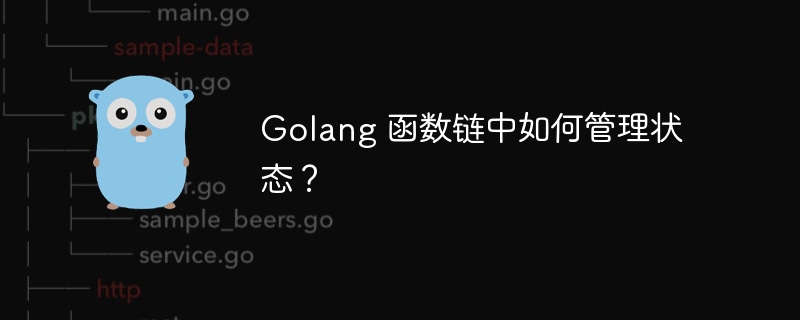Golang 函数链中如何管理状态?
时间:2024-09-20 22:49:07 466浏览 收藏
一分耕耘,一分收获!既然打开了这篇文章《Golang 函数链中如何管理状态?》,就坚持看下去吧!文中内容包含等等知识点...希望你能在阅读本文后,能真真实实学到知识或者帮你解决心中的疑惑,也欢迎大佬或者新人朋友们多留言评论,多给建议!谢谢!
Go 函数链中的状态管理有多种方法:闭包捕获变量、使用 channel 传递数据、HTTP 上下文、middleware 等。通过闭包,函数内部可以访问外部变量;channel 实现进程间通信;HTTP 上下文在请求和响应间传递数据;middleware 插入自定义逻辑,传递并修改数据。

Go 函数链中的状态管理
在 Go 函数链中管理状态是一个常见的挑战,因为函数是无状态的。然而,有时需要在函数链中传递和修改信息。本文介绍了在 Go 中管理函数链状态的几种方法,并提供了实战案例。
通过闭包捕获变量
最简单的方法是通过闭包捕获变量。闭包允许内部函数访问和修改外部函数范围内的变量,即使外部函数已返回。
func incrementCounter() func() {
counter := 0
return func() int {
counter++
return counter
}
}
func main() {
increment := incrementCounter()
fmt.Println(increment()) // 1
fmt.Println(increment()) // 2
fmt.Println(increment()) // 3
}通过 channel 传递数据
另一种方法是使用 channel 传递数据。channel 是 Go 中一种用于进程间通信的机制。它允许协程安全地交换数据。
func incrementCounter(ch chan int) {
counter := 0
for {
select {
case ch <- counter:
counter++
case <-ctx.Done():
return
}
}
}
func main() {
ctx, cancel := context.WithCancel(context.Background())
ch := make(chan int)
go incrementCounter(ch)
for {
select {
case counter := <-ch:
fmt.Println(counter) // 0, 1, 2, 3, ...
case <-ctx.Done():
cancel()
return
}
}
}通过 HTTP 上下文
如果您在 HTTP 上下文中,可以使用 HTTP 上下文传递数据。HTTP 上下文是请求和响应对象之间共享数据的机制。
func incrementCounter(w http.ResponseWriter, r *http.Request) {
counter, ok := r.Context().Value("counter").(int)
if !ok {
http.Error(w, "counter not found in context", http.StatusInternalServerError)
return
}
counter++
r.Context().Value("counter") = counter
fmt.Fprintf(w, "%d", counter)
}
func main() {
http.HandleFunc("/", incrementCounter)
http.ListenAndServe(":8080", nil)
}通过 middleware
middleware 是一个功能强大的技术,用于在 HTTP 请求处理中插入自定义逻辑。它可以用来传递和修改函数链中的数据。
func incrementCounter(next http.Handler) http.Handler {
return http.HandlerFunc(func(w http.ResponseWriter, r *http.Request) {
counter, ok := r.Context().Value("counter").(int)
if !ok {
counter = 0
}
counter++
ctx := context.WithValue(r.Context(), "counter", counter)
next.ServeHTTP(w, r.WithContext(ctx))
})
}
func main() {
handler := http.HandlerFunc(func(w http.ResponseWriter, r *http.Request) {
fmt.Fprintf(w, "counter: %d", r.Context().Value("counter"))
})
wrappedHandler := incrementCounter(handler)
http.Handle("/", wrappedHandler)
http.ListenAndServe(":8080", nil)
}通过上述方法,您可以轻松地在 Go 函数链中管理状态,满足您的特定需求。
终于介绍完啦!小伙伴们,这篇关于《Golang 函数链中如何管理状态?》的介绍应该让你收获多多了吧!欢迎大家收藏或分享给更多需要学习的朋友吧~golang学习网公众号也会发布Golang相关知识,快来关注吧!
-
505 收藏
-
503 收藏
-
502 收藏
-
502 收藏
-
502 收藏
-
334 收藏
-
463 收藏
-
498 收藏
-
287 收藏
-
494 收藏
-
282 收藏
-
469 收藏
-
215 收藏
-
265 收藏
-
439 收藏
-
314 收藏
-
331 收藏
-

- 前端进阶之JavaScript设计模式
- 设计模式是开发人员在软件开发过程中面临一般问题时的解决方案,代表了最佳的实践。本课程的主打内容包括JS常见设计模式以及具体应用场景,打造一站式知识长龙服务,适合有JS基础的同学学习。
- 立即学习 543次学习
-

- GO语言核心编程课程
- 本课程采用真实案例,全面具体可落地,从理论到实践,一步一步将GO核心编程技术、编程思想、底层实现融会贯通,使学习者贴近时代脉搏,做IT互联网时代的弄潮儿。
- 立即学习 516次学习
-

- 简单聊聊mysql8与网络通信
- 如有问题加微信:Le-studyg;在课程中,我们将首先介绍MySQL8的新特性,包括性能优化、安全增强、新数据类型等,帮助学生快速熟悉MySQL8的最新功能。接着,我们将深入解析MySQL的网络通信机制,包括协议、连接管理、数据传输等,让
- 立即学习 500次学习
-

- JavaScript正则表达式基础与实战
- 在任何一门编程语言中,正则表达式,都是一项重要的知识,它提供了高效的字符串匹配与捕获机制,可以极大的简化程序设计。
- 立即学习 487次学习
-

- 从零制作响应式网站—Grid布局
- 本系列教程将展示从零制作一个假想的网络科技公司官网,分为导航,轮播,关于我们,成功案例,服务流程,团队介绍,数据部分,公司动态,底部信息等内容区块。网站整体采用CSSGrid布局,支持响应式,有流畅过渡和展现动画。
- 立即学习 485次学习
